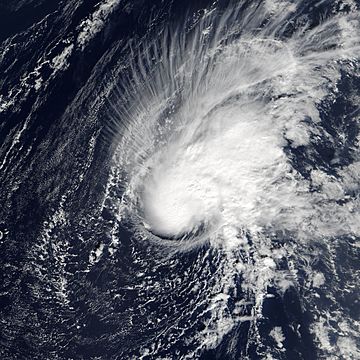Tropical Storm Zeta facts for kids
| Tropical storm (SSHWS/NWS) | |

Tropical Storm Zeta on January 4.
|
|
| Formed | December 29, 2005 |
|---|---|
| Dissipated | January 6, 2006 |
| Highest winds | 1-minute sustained: 65 mph (100 km/h) |
| Lowest pressure | 994 mbar (hPa); 29.35 inHg |
| Fatalities | None reported |
| Damage | None |
| Areas affected | No land areas |
| Part of the 2005 Atlantic hurricane season | |
Tropical Storm Zeta was the very last storm of the 2005 Atlantic hurricane season. It formed super late in the year, on December 30, 2005. This was after the official end of the hurricane season!
Zeta was a very rare tropical cyclone because it lasted through two different calendar years. It formed in the middle of the Atlantic Ocean and stayed far from land its whole life. Even though experts thought it would disappear fast, Zeta surprised everyone. It reached its strongest point on January 2, 2006, and finally faded away on January 8, 2006.
Contents
How Tropical Storm Zeta Formed and Moved
A tropical depression started to form in the central Atlantic Ocean on December 29, 2005. This happened from something called a "frontal trough," which is like a line where different air masses meet. The next day, it grew into a tropical storm. This was more than a month after the hurricane season usually ends!
Because it was so late, the National Hurricane Center (NHC) didn't even officially name it until it was already a tropical storm. Tropical Storm Zeta first moved northwest. Then, it paused for a few hours on December 31 before heading west.
Zeta's Surprising Strength
As Tropical Storm Zeta slowly got stronger, it acted a lot like Hurricane Epsilon. The NHC kept predicting that Zeta would get weaker because of high wind shear. Wind shear is when winds blow at different speeds or in different directions at different heights. This usually tears storms apart.
But Zeta held onto its strength, just like Epsilon had done. This was very unusual!
Forecasters Are Stumped
Tropical Storm Zeta weakened a little bit on January 2, 2006. But then it got stronger again, reaching its top winds of 65 mph (100 km/h) on the same day. One computer model even thought Zeta might become a hurricane, but it didn't.
Zeta kept defying predictions that it would weaken. By January 4, forecasters at the NHC were getting frustrated. One forecaster, Dr. Lixion Avila, even said he had "run out of things to say" about the storm!
Zeta Finally Weakens
The strong wind shear finally started to affect Tropical Storm Zeta on January 4. Zeta's strength began to drop, making it a very weak tropical storm. The NHC still thought Zeta would disappear faster than it did.
Early on January 5, they even said Zeta had weakened into a tropical depression. But they later found out this was wrong. Zeta kept moving west-northwest, barely holding onto its tropical storm status. It became disorganized again. Zeta finally weakened into a tropical depression on January 6 and then faded away completely later that day. This officially brought the 2005 hurricane season to an end.
Even after it was no longer a storm, the leftover low-pressure area stayed together for one more day. It finally disappeared about 660 miles (1060 km) southeast of Bermuda.
How Tropical Storm Zeta Affected People
Tropical Storm Zeta never came close to land, so it didn't cause any damage or deaths. No special warnings were needed for coastal areas.
However, some people taking part in the 2005 Atlantic Rowing Race felt the effects of Zeta. They reported heavy seas and strong, unpleasant winds. The ship Liberty Star also reported strong winds from Tropical Storm Zeta. On December 31, the ship experienced 40 mph (65 km/h) winds when it was about 45 miles (75 km) north of the storm's center.
Zeta's Special Records
Tropical Storm Zeta set a few interesting records:
- When it formed on December 31, 2005, it became the second-latest tropical cyclone ever recorded in the Atlantic Ocean. It formed about six hours earlier than Hurricane Alice did in 1954.
- Zeta is only the second Atlantic tropical cyclone ever recorded to have lasted through two different calendar years (the other was Hurricane Alice).
- Tropical Storm Zeta also made the 2005 season have a record number of storms: twenty-eight! This was seven more than the previous record from 1933.
- It was the only Atlantic storm ever to have a name starting with the letter "Z." This is because the official lists of names for Atlantic storms don't usually include "Z" names.
Related Pages
- NHC's archive on Tropical Storm Zeta


